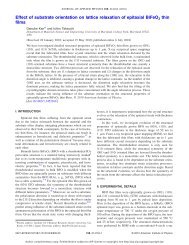Combinatorial and High-Throughput Screening of Materials ...
Combinatorial and High-Throughput Screening of Materials ...
Combinatorial and High-Throughput Screening of Materials ...
Create successful ePaper yourself
Turn your PDF publications into a flip-book with our unique Google optimized e-Paper software.
ACS <strong>Combinatorial</strong> Science<br />
REVIEW<br />
Table 2. Selected Examples <strong>of</strong> Real-Time Monitoring <strong>of</strong> <strong>Combinatorial</strong> Reactions: Instrumentation <strong>and</strong> New Knowledge<br />
materials system instrumentation knowledge ref<br />
solid-phase synthesis<br />
<strong>of</strong> trisubstituted<br />
amines<br />
metal alloys<br />
catalyst c<strong>and</strong>idates<br />
96-capillary array for<br />
palladium-catalyzed<br />
annulation<br />
solid-phase organic<br />
synthesis products<br />
resin-bead supported<br />
combinatorial libraries<br />
solid-phase peptide<br />
synthesis products<br />
catalytic dehydrogenation<br />
<strong>of</strong> cyclohexane to<br />
benzene<br />
amorphous microporous<br />
mixed oxide catalysts<br />
bead-bound catalysts<br />
styrene-polymerization<br />
catalysis<br />
catalytic activity <strong>of</strong><br />
V 2 O 5 in oxidation <strong>of</strong><br />
naphthalene to<br />
five-step reaction sequence on resin is followed the<br />
reaction step-by-step using the sequence <strong>of</strong> five<br />
analytical tools as a function <strong>of</strong> experiment time:<br />
single bead IR, 1 H MAS NMR, 2D MAS COSY,<br />
MAS HMQC, 13 C MAS NMR<br />
generation <strong>of</strong> a protocol <strong>of</strong> analytical tools that allows<br />
a chemist to decisively evaluate synthetic steps,<br />
verify new building blocks, <strong>and</strong> detect possible side<br />
reactions prior to or during actual library construction<br />
498<br />
serial MS screening <strong>of</strong> a 15 15 15 libraries with 120 kinetics <strong>of</strong> catalytic reactions 499<br />
different compositions<br />
nonaqueous multiplexed capillary electrophoresis rapid determination <strong>of</strong> catalytic activity, selectivity <strong>and</strong> 59<br />
kinetics <strong>of</strong> the various combinations<br />
single-bead FTIR reaction kinetics, conversion yield 93<br />
hyperspectral IR imaging for monitoring <strong>of</strong> catalytic kinetics <strong>of</strong> catalytic reactions 500<br />
reactions with the screening time independent <strong>of</strong> the<br />
number <strong>of</strong> elements in the library<br />
near-IR multispectral imaging based on scanning<br />
simultaneous determination <strong>of</strong> kinetics <strong>of</strong> multiple<br />
501<br />
acousto-optic tunable filter<br />
reactions<br />
resonance-enhanced multiphoton ionization for low determination <strong>of</strong> activities <strong>of</strong> catalyst sites by monitoring 502<br />
parts per billion <strong>and</strong> high parts per trillion detection <strong>of</strong> a single reaction product; possibility for monitoring <strong>of</strong><br />
capability<br />
multiple reaction products to determine catalyst selectivity<br />
IR thermography for gas-phase screening <strong>of</strong> catalyst kinetics <strong>of</strong> catalytic reactions 488<br />
c<strong>and</strong>idates (sample size 200 μg)<br />
IR thermography for solution-phase screening <strong>of</strong><br />
kinetics <strong>of</strong> catalytic reactions 503<br />
3150 potential catalysts bound to 300 500 μm<br />
diameter polymer beads<br />
IR thermographic imaging <strong>of</strong> organometallic catalysts reaction kinetics from the time dependence <strong>of</strong> the<br />
504<br />
heat generation<br />
fluorescence <strong>and</strong> thermographic imaging for<br />
determination <strong>of</strong> nonspecific temperature increase<br />
505<br />
monitoring <strong>of</strong> catalytic reactions<br />
by thermography <strong>and</strong> species-specific concentration maps<br />
by fluorescence<br />
naphthoquinone by O 2<br />
48 element array <strong>of</strong><br />
epoxy formulations<br />
discrete array <strong>of</strong><br />
inorganic oxide films<br />
electrochemical<br />
catalysts<br />
catalytic hydrogenproducing<br />
materials<br />
organic coating<br />
formulations<br />
chemical <strong>and</strong><br />
biochemical catalysts<br />
libraries <strong>of</strong> polymer/<br />
pigment compositions<br />
automated large sample array differential scanning<br />
calorimeter for process optimization for screening<br />
studies <strong>of</strong> multivariable arrays<br />
pulsed laser deposition with in situ monitoring <strong>of</strong> growth<br />
surface with reflection high energy electron<br />
diffraction (RHEED).<br />
fluorescence imaging <strong>of</strong> catalysts for oxidation <strong>of</strong><br />
methanol using a pH indicator in discovery <strong>and</strong><br />
focus libraries<br />
near-IR reflection sensor array for 2-D mapping <strong>of</strong><br />
H 2 from catalytic hydrogen-producing materials<br />
optimization <strong>of</strong> processing conditions (curing parameters)<br />
in fabrication <strong>of</strong> UV-cured automotive organic protective<br />
coatings. Fluorescence <strong>of</strong> a viscosity-sensitive molecular<br />
probe monitored during curing <strong>of</strong> coatings.<br />
96-thermistor array for detection <strong>of</strong> temperature changes<br />
with a 0.1 mK resolution<br />
fluorescence spectroscopy <strong>and</strong> imaging for the evaluation<br />
<strong>of</strong> oxidative stability (weathering) <strong>of</strong> polymer/pigment<br />
compositions under conventional test conditions<br />
cure kinetics 506<br />
one-lot optimization <strong>of</strong> epitaxial growth process by using a 507<br />
carrousel type masking plate. Variable growth conditions<br />
include pressure, temperature, laser energy <strong>and</strong> laser<br />
repetition rate<br />
kinetics <strong>of</strong> catalytic reactions 164<br />
kinetics <strong>of</strong> catalytic reactions 508<br />
rapid decoupling <strong>of</strong> temperature <strong>and</strong> radiation effects in 509<br />
curing <strong>of</strong> UV curable coating formulations by using<br />
multiple coatings <strong>and</strong> process conditions at once<br />
correlation <strong>of</strong> catalysts concentration <strong>and</strong> time-dependent 510<br />
recorded maximum temperature<br />
multiple levels <strong>of</strong> end-use testing conditions provide more 511<br />
reliable ranking <strong>of</strong> performance <strong>of</strong> materials. Similar kinetic<br />
rates <strong>of</strong> weathering <strong>of</strong> polymers with quite different pigments<br />
were found<br />
583 dx.doi.org/10.1021/co200007w |ACS Comb. Sci. 2011, 13, 579–633












